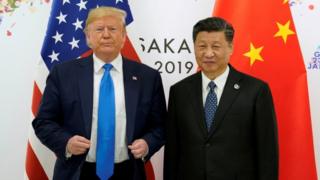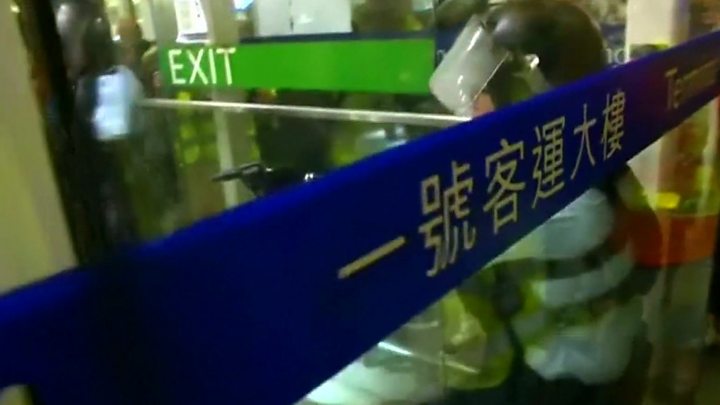
Image copyright
Reuters
US President Donald Trump has suggested a “personal meeting” with Chinese President Xi Jinping over Hong Kong
US President Donald Trump has suggested a “personal meeting” with Chinese President Xi Jinping to discuss the political crisis engulfing Hong Kong.
In a tweet Mr Trump said he had “ZERO doubt” that Mr Xi could “humanely solve the Hong Kong problem”.
He also tied the protests to a US trade deal with Beijing, in the face of ongoing trade tensions.
“Of course China wants to make a deal. Let them work humanely with Hong Kong first!” he tweeted.
Mr Trump’s comments come after weeks of tumultuous pro-democracy protests sparked by opposition to an extradition bill in Hong Kong.
Critics feared the bill would bring Hong Kong more decisively under China’s control.
The bill has now been suspended, but the protests have evolved into a broader pro-democracy movement.
- How could China intervene in Hong Kong protests?
- In pictures: Hong Kong protesters occupy terminal
- Hong Kong protests in 300 words
Hong Kong is part of China under a “one country, two systems” model that grants it a high level of autonomy.
It has its own legal system and judiciary and enjoys certain freedoms not seen in the mainland – Hong Kong and Macau for example, are the only places in Chinese territory where people can hold vigils commemorating Tiananmen Square.
Tensions and tear gas
Tensions between demonstrators and police have escalated in recent days, with Hong Kong leader Carrie Lam warning the city could be “pushed into an abyss”.
The Chinese government has strongly criticised the protesters, calling their behaviour “close to terrorism”.
On Wednesday evening, police armed with riot shields fired tear gas to disperse hundreds of demonstrators gathered in the Sham Shui Po neighbourhood, who had been shining laser pointers at a police station.
Laser pointers have gained significance in the protests after a student was arrested for possessing laser pointers, which police described as an “offensive weapon” that could cause serious eye injuries.
Since then, demonstrators have used lasers as a way of ridiculing the claim.
Image copyright
Getty Images
Demonstrators are now using laser pointers as a sign of protest
Wednesday’s tear gas came a day after protests at Hong Kong’s International Airport turned violent on Tuesday night.
Thousands of protesters flooded the terminal buildings, using luggage trolleys to build barriers.
The gathering started off as a peaceful mass sit-down, but things escalated and a mainland Chinese journalist was set upon by protesters who accused him of being an undercover police officer. The situation deteriorated further after police officers used pepper spray against some demonstrators while trying to evacuate an injured man.
Clashes soon broke out between protesters and police, and in one instance, a policeman was seen frantically drawing his gun after being attacked with his own truncheon for manhandling a woman.
Hong Kong police said the officer’s life was “under great danger” and insisted he only drew his gun “out of emergency and necessity”.
Protesters had boxed him into a corner after prying the baton from his hands during a violent skirmish. After collapsing to the ground, the policeman was eventually dragged to safety by his fellow officers.

With disruption striking Hong Kong’s infrastructure and no resolution in sight, activists fear a direct military intervention by China – though analysts believe this is unlikely to happen.
Separately, the US president’s national security advisor, John Bolton, warned China on Wednesday to tread “carefully” in Hong Kong “because people in America remember Tiananmen Square”.
A repeat of the military crackdown on the 1989 student-led protests in China would be a “big mistake”, he told news outlet Voice of America.



